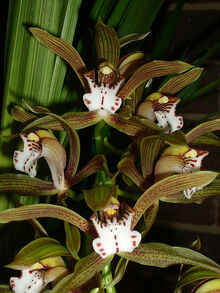| Cymbidium erythraeum | |||||||||||||||||
|---|---|---|---|---|---|---|---|---|---|---|---|---|---|---|---|---|---|
| |||||||||||||||||
Description Edit
Edit
Plant blooms from late summer to fall with five to fourteen 5 cm wide flowers. Flowers are fragrant.
Distribution Edit
Edit
Plant is found growing in the coniferous forest of Kumaon, Sikkium, and Assam states of India; Nepal; Bhutan; Myanamar; Yunnan; Sichuan; and Xizang China; and Vietnam at elevations of 1000 to 2800 meters
Culture Edit
Edit
Plant should be grown in cool areas with medium to bright light. Pot with bark and perlite. Plant prefers dry periods between watering. Reduce watering during the winter. Water about once a week.
Plants epiphytic or lithophytic, autotrophic. Pseudobulbs ovoid, bilaterally flattened, 2-6 × 1.5-3 cm, enclosed in leaf bases. Leaves distichous, 5-12, deep green tinged purple at base, lorate, 35-90 × 0.7-1.5 cm, articulate 2.5-6.5 cm from base. Inflorescence arising from within sheaths at base of pseudobulb, suberect or arching, 40-75 cm, slender; rachis 23-29 cm, 3-8-flowered; floral bracts subtriangular, 2-4 mm. Flowers fragrant, 6.5-8 cm in diam.; pedicel and ovary 25-43 mm; sepals and petals green with heavy reddish brown longitudinal stripes and irregular spots of same color, or uniformly greenish yellow; lip pale yellow or white with red-brown venation on lateral lobes and a few red-brown spots and a central longitudinal dash on mid-lobe, or white with yellow venation on lateral lobes and scattered yellow spots on mid-lobe. Sepals narrowly oblong-oblanceolate to narrowly obovate-oblong, 34-52 × 7-14 mm, apex acute to obtuse. Petals falcate, ligulate, 33-53 × 4-7 mm, apex acute; lip elliptic-ovate, 24-43 mm, base fused to basal margins of column for 2-3 mm, 3-lobed; lateral lobes erect, subovate, sometimes shortly ciliate; mid-lobe slightly recurved, cordate to ensiform, 8-9 × 10-11 mm, sometimes sparsely shortly hairy; disk densely hairy at apices of lateral lobes, papillate near base and on mid-lobe, with 2 puberulent lamellae extending to base of mid-lobe; lamellae slightly swollen toward apices. Column 23-32 mm, narrowly winged, sparsely hairy toward base; pollinia 2, subtriangular. Capsule fusiform-ellipsoid, 40-50 × 20-30 mm. Fl. Oct-Jan, fr. Mar-May. 2n = 40, 42.
Trees and rocks at forest margins and in forests; 1400-2800 m. C and SW Guizhou, SW Sichuan, SE Xizang, NW, SE, and W Yunnan [Bhutan, India, Myanmar, Nepal, Vietnam].
| |||||
References
1. Ref1
2.Ref 2
3.Ref 3

No comments:
Post a Comment